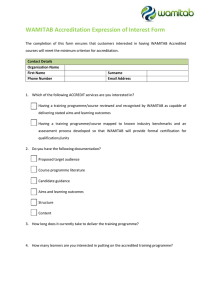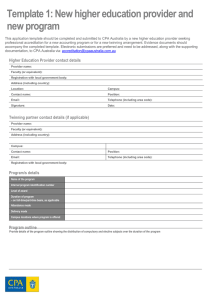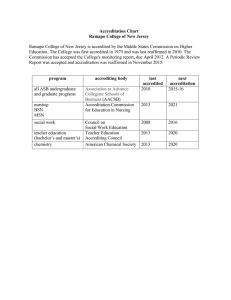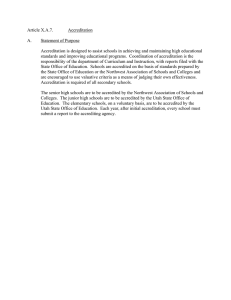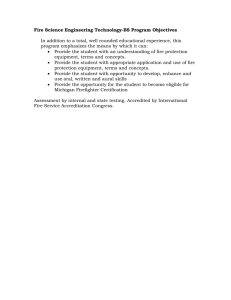AQTF 2007 Standards for Course Accreditation
advertisement
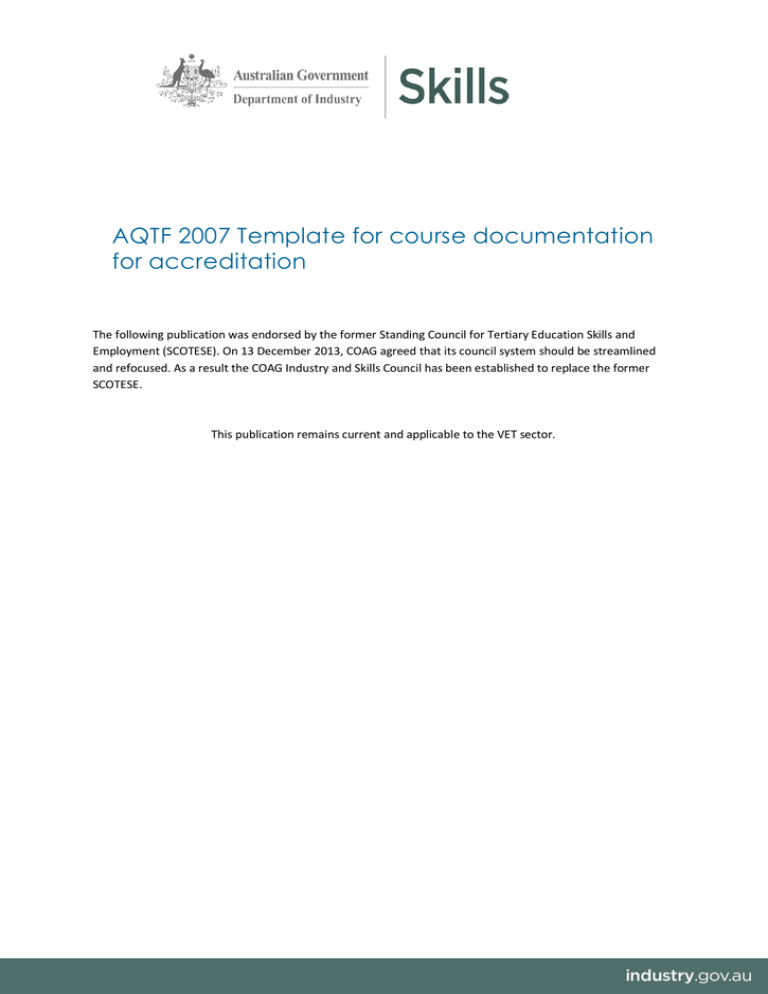
AQTF 2007 Template for course documentation for accreditation The following publication was endorsed by the former Standing Council for Tertiary Education Skills and Employment (SCOTESE). On 13 December 2013, COAG agreed that its council system should be streamlined and refocused. As a result the COAG Industry and Skills Council has been established to replace the former SCOTESE. This publication remains current and applicable to the VET sector. AQTF 2007 Standards for Course Accreditation Template for course documentation for accreditation This national template is designed to assist in the development of courses for accreditation and re-accreditation under AQTF 2007. The template is divided into three sections (A, B and C) which together form the course documentation. The course document (Sections A, B and C) is the legally recognised specification for the course. It provides the basis for the development of strategies for training and assessment by each RTO and describes essential course information. Section A provides information about copyright and course classification Section B contains details of industry need, and the rules under which the course may be accessed, delivered and assessed Section C includes the units of competency or modules that are contained in the course. AQTF 2007 Template for course documentationfor accreditation.docx Page 1 of 12 Section A: Copyright and course classification information 1. Copyright owner of the course Provide the name of the legal entity or individual who owns copyright of the course(s) being submitted for accreditation. Provide both the ongoing organisational contact details and the day to day contact details where these are different. 2. Address Provide street, postal and email address of the legal entity or individual that is the copyright owner. 3. Type of submission State whether the submission is for accreditation or reaccreditation. 4. Copyright acknowledgement Ensure copyright approval for any units or modules not owned by your organisation. Commonwealth owned materials such as Training Packages are licenced under the Free Education licence. Details are available at www.aesharenet.com.au/FfE2 5. Licencing 6. and franchise Indicate if this course may be used under licence or franchise and if relevant state requirements for use by other providers. Provide contact details for these arrangements. 7. Course accrediting body Provide the name of the state or territory course accrediting body responsible under legislation. 8. AVETMISS information Provide AVETMISS classification codes that describe the industry, occupational group and field of education for which the course is intended. ASCO code Insert code and description (Australian Standard Classification of Occupationsoccupational type To be replaced by ANZSCO [Australian and New Zealand Standard classification of Occupations]) ASCED Code – 4 digit Insert code and description (Field of education) National course code To be provided by the course accrediting body once the course is accredited [Classification codes for AVETMISS data may be found on the NCVER website at www.ncver.edu.au] 9. Period of accreditation Include details of the requested period of accreditation. Accreditation dates will be confirmed by the course accrediting body once the course is accredited. AQTF 2007 Template for course documentationfor accreditation.docx Page 2 of 12 Section B: Course information 1. Nomenclature Name of the Qualification Standard 1 for accredited courses. State the name(s) of the qualification(s) that will be awarded on successful completion of the course. State the nominal duration of the course(s) in hours. Nominal duration of the course Vocational or educational outcomes of the course Standard 1 for accredited courses. 3. Development of the course Standards 1 and 2 for accredited courses. 3.1 Industry/ enterprise / community needs Provide evidence of industry/ enterprise / community need and support for the course and describe the consultation and validation process. 2. State the intended purpose of the course. Identify the major client and /or industry groups. Confirm the proposed award is not covered by a qualification within a Training Package. 3.2 Review for re-accreditation Standards 1 and 2 for accredited courses. If applying for re-accreditation, provide details of how monitoring and evaluation have been taken into account in the revised course. Detail any transition arrangements from the existing course to the new course for learners currently enrolled in the existing course. 4. Course outcomes Standards 1, 2 and 3 for accredited courses. 4.1 Qualification level Describe how the intended course outcomes are consistent with the proposed AQF qualification for the course. 4.2 Employability skills Standard 4 for accredited courses. Provide a summary of the employability skills to be achieved in the course. If the course only leads to a Statement of Attainment (e.g. Course in), this is optional. 4.3 4.4 Recognition given to the course (if applicable) Standard 5 for accredited courses. Licensing/ regulatory requirements (if applicable) Standard 5 for accredited courses. State the recognition given to the course(s) by professional or industry bodies, if applicable, for example by granting membership. State the extent to which the course satisfies licensing/ AQTF 2007 Template for course documentationfor accreditation.docx Page 3 of 12 regulatory requirements, if applicable. 5. Course rules Standards 2, 6, 7 and 9 for accredited courses. 5.1 Course structure All qualifications identified in the structure must be accredited in their own right and assigned an NTIS course code. Course structure may be presented in table format or as a combination of text and table, including guidelines on sequencing, pre-requisites and nominal hours. 1. Outline the structure of the course and rules for completion. Course structure will reflect the intended skill and knowledge outcomes of the course and may be: core only core and electives core and specialisations core, specialisations and electives electives only 2. Any exit points from the course that provide for vocational or educational outcomes should be identified. 3. Include a statement that a Statement of Attainment will be issued for any unit of competency/ module completed if the full qualification is not completed. 5.2 Entry requirements Standard 9 for accredited courses. Describe entry requirements essential to the course. Wherever possible, these should be expressed in terms of competencies. Limitations to entry should be justified. Recommended entry requirements (including language, literacy and numeracy skills) that are likely to facilitate successful completion of the course by the intending participant may also be included. 6. 6.1 Assessment Assessment strategy Standard 10 and 12 for accredited courses. 1. Describe the course assessment strategy in terms of how it effectively judges participants’ achievement of outcomes. The strategy should outline the approach to assessment and evidence gathering to be followed by the RTO, including any mandated and/or recommended modes of assessment. 2. Describe how assessment of the course will be consistent with the AQTF 2007 Essential Standards for Registration and identify course assessment strategies which: are consistent with the assessment guidelines in the relevant Training Package(s) where nationally endorsed units of competency are used ensure that workplace and regulatory requirements, where relevant, are met AQTF 2007 Template for course documentationfor accreditation.docx Page 4 of 12 6.2 Assessor competencies justify mandatory workplace assessment, or assessment through simulation if these are to be used and include advice on how they may be achieved identify any special arrangements that may facilitate Recognition of Prior Learning. Standard 12 for Accredited Courses 1. Confirm compliance with the requirements for the competence of staff involved in assessment in the AQTF 2007 Essential Standards for Registration and provide guidance on the vocational competency requirements for assessors. 2. Justify any requirements above the requirements in the AQTF 2007 Essential Standards for Registration for the competencies of assessors. 7. Delivery Standards 11 and 12 for Accredited Courses 7.1 1. Identify and justify any delivery modes essential to the delivery of this course, particularly on-the-job training. Delivery mode 2. Identify and justify any limitations to the delivery modes that may be chosen for this course. 3. Identify any educational support mechanisms for maximising participants’ completion of the course. 4. Indicate how the course may be varied to reflect the needs of learner groups through the contextualisation of units or other means where appropriate. 7.2 Resources Standard 12 for Accredited Courses 1. Provide details of specialised facilities and equipment essential for the delivery of the course. 2. Provide advice on the vocational competency requirements for trainers. Any requirements above the requirements of the AQTF 2007 Essential Standards for Registration must be justified. 3. Units of competency that have been imported from Training Packages must reflect the requirements for trainers specified in that Training Package. 8. Pathways and articulation Standard 8 for accredited courses 1. Provide details of potential pathways for course participants, both into the course and into other VET and higher education courses on completion, including details of any formalised articulation and/or credit transfer arrangements. 2. If this course contains nationally endorsed units of competency, identify any connections with other Training Package qualifications that are relevant to vocational pathways for course graduates. AQTF 2007 Template for course documentationfor accreditation.docx Page 5 of 12 9. Ongoing monitoring and evaluation Standard 13 for accredited courses 1. Describe arrangements that the copyright owner proposes to use for monitoring and evaluating the course to maintain its relevancy and currency. 2. Confirm that significant changes to the course resulting from course monitoring and evaluation procedures will be notified to the course accrediting body. AQTF 2007 Template for course documentationfor accreditation.docx Page 6 of 12 Section C: Units of Competency contained in the course (or modules, where relevant) The following must be included: 1. A list of the units of competency imported from Training Package/s (Note: the title and code of the units must be current and the same as the title and code used in the Training Package) And / or 2. The units of competency for the course which comply with the relevant requirements for the Training Package Development Handbook* * The sample on the following pages from the Training Package Development Handbook shows the sequence of components of units of competency and provides developers with advice on completing each component. The advice to developers is provided in the cells, and in the footnotes. Note also that explanatory notes are provided for users of the unit—these notes are in smaller font below the subheading in some cells, and should be retained in the final unit version. Remove the footnotes – these provide explanations for developers only). And / or 3. Modules for the course (Note: modules may be included where the copyright owner can establish to the satisfaction of the course accrediting body, prior to development, that it is not possible to develop appropriate competency standards. A module template is available from the course accrediting body). AQTF 2007 Template for course documentationfor accreditation.docx Page 7 of 12 XXXABC203 Title of unit in sentence case (maximum of 100 characters including spaces between words) Broad description reflective of content. Do not include justification statements. Unit Descriptor Describe any relationships to the unit. This unit partially covers the skills of … (state unit code followed by title). This unit has been contextualised and is based on … (state unit code followed by title. If the unit is contextualised advise on whether its outcomes are the same as the original and whether there is one or two way equivalence.) Where licensing, legislative, regulatory or certification requirements exist, describe the unit’s relationship. Where none exist, insert the following statement: ‘No licensing, legislative, regulatory or certification requirements apply to this unit at the time of publication.’ Employability Skills The text for Employability Skills, inserted after the unit descriptor, will be as follows: This unit contains Employability Skills. Pre-requisite Unit(s) (Optional – omit if it does not apply) Application of the Unit List any mandatory pre-requisite units to be completed prior to commencement of this unit. Minimise requirements for pre-requisite units and avoid units which also have pre-requisite units. Describe the unit’s application within the workplace. Keep in mind that it may be imported into other qualifications for other industries so do not make it too job specific. You may indicate various environments, complexities and situations in which the skills and knowledge may be applied. Describe application of the unit in a way industry will find useful for the purposes of job descriptions, recruitment advice or job analysis. Competency Field (Optional – omit if it does not apply) Identify the industry’s broad skill area. The need for this will vary between industries but essentially it classifies the units. In some cases units are classified according to Common units or according to a broad skill area such as Business Management or Agriculture. This could be further refined under Sector. AQTF 2007 Template for course documentationfor accreditation.docx Page 8 of 12 Sector (Optional – omit if it does not apply) Identify the industry’s sector. This is a further categorisation of competency field and identifies the next classification, for example an Elective, Supervision or Farming field. ELEMENT PERFORMANCE CRITERIA Elements describe the essential outcomes of a unit of competency. Performance criteria describe the required performance needed to demonstrate achievement of the element. Where bold italicised text is used, further information is 1 detailed in the required skills and knowledge and/or the range statement. 2 Assessment of performance is to be consistent with the evidence guide. Use active voice3 1 1.1 Use passive voice4 1.2 1.3 2 2.1 2.2 2.3 3 3.1 3.2 3.3 1 Where bold italicised text has not been used in the Performance Criteria, delete this sentence from the text. Use bold/italicised text and elaborate in the Range Statement. Not all Performance Criteria are limited to this approach. Additional information would also be provided under the Skills and Knowledge category. 2 Include this text in 10-point font in every unit by way of explanation. 3 State the outcome required. Make statement in active voice (preferred but not mandated). That is, commence with a verb before the subject and make the statement precise and direct. For example, ‘Confirm site access and conditions.’ Avoid commencing with words such as ‘You will be able to…’ as these do not add value. 4 Use passive voice (preferred but not mandated). In passive voice the subject is before the verb. For example: ‘Site access and conditions are confirmed.’ AQTF 2007 Template for course documentationfor accreditation.docx Page 9 of 12 REQUIRED SKILLS AND KNOWLEDGE 5 This describes the essential skills and knowledge and their level, required for this unit . Provide details of required skills/knowledge associated with this unit6. RANGE STATEMENT7 8 The range statement relates to the unit of competency as a whole. It allows for different work environments and situations that may affect performance. Bold italicised wording in the Performance Criteria is detailed below. Add any essential operating conditions that may be present with training and assessment depending on the work situation, 9 needs of the candidate, accessibility of the item, and local industry and regional contexts. EVIDENCE GUIDE10 The evidence guide provides advice on assessment and must be read in conjunction with the Performance Criteria, 11 Required Skills and Knowledge, the Range Statement and the Assessment Guidelines for this Training Package. Overview of Assessment (Optional) 12 Provide an overview of how assessment could be undertaken, rather than what is to be assessed.13 Critical aspects for assessment and The critical aspects should reflect what someone competent evidence required to demonstrate in the workplace is able to do and what is acceptable competency in this unit evidence to permit an assessor to make a professional judgment. Evidence gathered is to be related to: information which forms the basis of the professional 5 Include this text in 10-point font in every unit by way of explanation. Describe the essential skills and knowledge - either separately identified or combined. Use single column format with items bulleted not numbered. Do not use generic statements such as ‘research techniques’ or ‘workplace procedures’ as these add little value. Create a strong and clear association with the specifics of the unit and its required outcomes. Clarify the parameters of the skills and knowledge – for example by setting an upper and lower limit. Knowledge identifies what a person needs to know to perform the work in an informed and effective manner. Skills describe the application of knowledge and situations where understanding is converted into a workplace outcome. Simple words such as ‘time management’ are inappropriate – in that example, ask yourself ‘what is time specific about performance in the competency?’ – that is what needs to be described. 7 Show the text in the Range Statement in a two-column format – the heading in the left hand column with detail in the right hand column. Bullet, rather than number statements in the right hand column. Include more than just an expansion of the bold italicised Performance Criteria text in the Range Statement truly reflect the options. Where bold italicised Performance Criteria text is expanded in the Range Statement, they must be in the same sequence as they appear in the Performance Criteria. Where a range of operating conditions is defined, add specific information as to whether competent performance has to be achieved and assessed under some or all of those conditions. Clarify how items in the Range Statement can be assessed. 8 Include this text in 10-point font in every unit by way of explanation. 9 Include the sentence above where bold italicised text has been used in the Performance Criteria and omit where it has not. 10 The Evidence Guide text is in a two-column format: the heading in the left column and detail in the right column. Statements in the right column are bulleted, not numbered. 11 Include this text in 10-point font in every unit by way of explanation. 12 An optional field - it will apply to some units but in most instances it is related to the assessment pathway. 13 More appropriate to use passive voice. 6 AQTF 2007 Template for course documentationfor accreditation.docx Page 10 of 12 judgment of the assessor; evidence required to demonstrate consistent performance; how assessment may be undertaken in certain circumstances; whether direct observation is a requirement; any special requirements at the unit level in regard to assessment for licensing, regulatory, legislation or certification; and do not merely repeat information from the Performance Criteria. Context of and specific resources for assessment Include advice on the context and conditions under which assessment may take place, and specific resources required for conducting assessment, eg describe particular environments that may apply for a valid and reliable assessment to occur. This could include real customers or an actual production or workplace environment where this is absolutely critical. Consider advice related to how consistency of performance can be assessed over time. Identify the specific resources that are essential for assessing this particular unit. Essential resources identified are for the purposes of assessment rather than teaching. Method of assessment14 Provide suggested strategies and methodologies for assessment that relate directly to the content and the environment for the unit. It should not be a standard quote applicable to all units. Include advice on the relationship of the unit to other units including units of competency that would logically benefit from being assessed and/or delivered 14 The method of assessment may should identify particular method of assessment that are deemed critical – for example, the competency of navigating a boat through a channel may be impossible to be assessed in a simulated situation. AQTF 2007 Template for course documentationfor accreditation.docx Page 11 of 12 together (sometimes referred to as co-requisites) Unacceptable assessment methods for the particular unit may be identified. Guidance information for assessment (Optional) Include any other information that may assist or guide assessment. This could include case studies or exemplars. Note: Optional fields may be omitted in some but not necessarily all units of competency– this is a judgement call – in some cases the field will add value to the unit and in other cases it will be superfluous. AQTF 2007 Template for course documentationfor accreditation.docx Page 12 of 12
